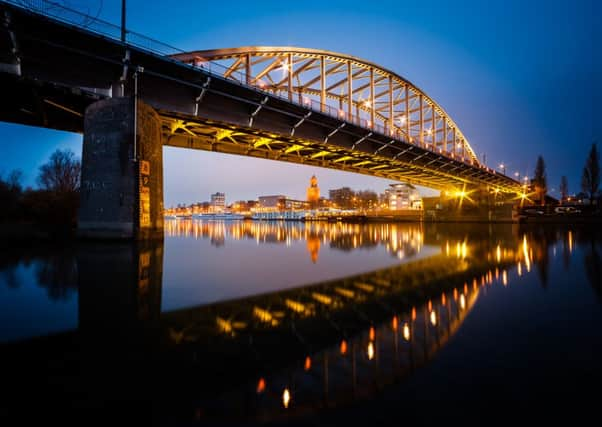The trail to Downfall


Remembrance runs as deep as the Waal here, close to the border with Germany. Even the name of the bridge, The Crossing, commemorates the troops who set out in flimsy rafts under murderous fire to try to liberate Nijmegen.
Theirs was one of many acts of bravery as battle raged across this landscape in the autumn of 1944, as an audacious, yet ultimately doomed, attempt to bring the war to an end developed into a desperate fight for survival.
Advertisement
Hide AdAdvertisement
Hide AdCaught its midst were the Dutch people, who have never forgotten nor ceased to show their gratitude for the Allied attempt to free them from Nazi tyranny, despite paying a terrible price as a consequence. They were the subject of brutal reprisals, saw their homes and cities flattened, and starved to death in their thousands during the bitter winter that followed.
In this year of so much remembrance of two world wars, the 70th anniversary of Operation Market Garden in September is a notable milestone. Market Garden was the massive airborne and land assault to open up an invasion route to Germany. With France liberated following the D Day landings, the Allies turned their attention to bringing the war to an end by punching through enemy territory and capturing bridges.
It was the biggest airborne operation in history, with almost 35,000 British, American and Polish troops descending by parachute and glider as ground forces tried to link up with them by charging up a road where the fighting was so savage that it was dubbed Hell’s Highway.
But from the moment it began, the operation went wrong. Paratroopers dropped straight onto a crack German unit, and were shot in the air, radios did not work, units became split up, and the ground forces could not get through.
Advertisement
Hide AdAdvertisement
Hide AdThe operation turned into a fight for survival, with large numbers of British troops being taken prisoner, and those who escaped having to cross the Rhine under cover of darkness.
In Britain, Market Garden is best known for the heroic stand that a small force from the Parachute Regiment made at the bridge over the Rhine at Arnhem against overwhelming opposition – the story told in A Bridge Too Far.
Arnhem suffered grievously as a result. The Germans flattened it, and hung on for another seven months until it was finally liberated by Yorkshire troops of the West Riding Division.
The city will be at the heart of the commemorations – though the Dutch authorities are keen that all the other acts of bravery that took place from September 17-25, 1944 are remembered. They also want to broaden awareness of the entire story of Market Garden, so that visitors understand that even though it was ultimately a failure, it paved the way for the final assault on Germany.
Advertisement
Hide AdAdvertisement
Hide AdAnd key to that understanding is a new trail called the Liberation Route, which received its official launch during the D Day commemorations in June.
The trail leading to the Dutch bridges fought over so desperately begins in the Home Counties, with the start of a series of more than 80 stone monuments that stretches through France, Belgium and Holland, chronicling key moments in the freeing of Europe from Nazi occupation.
At each monument, a free MP3 download or smartphone app brings up a narration and dramatisation of what happened in 1944 and early 1945.
Around Arnhem, the monuments tell the story of the battle for the bridge. The original was destroyed in the fighting, but its replacement is a replica named after John Frost, the lieutenant-colonel who led the stubborn opposition until he and his men were overwhelmed and captured, among the 11,000 Allied troops taken prisoner during the fighting. Close by is the Airborne Museum at Oosterbeek, British headquarters during the battle. The museum has been revamped and expanded, with new interactive displays and a reconstruction of battle-ravaged Arnhem.
Advertisement
Hide AdAdvertisement
Hide AdA short drive away, the National Liberation Museum, at Groesbeek, features a striking parachute-shaped building in which the names of all the Allied soldiers who died are listed on stone pillars.
Just over the border is another intensely moving site that brings the scale of the battle home. The Reichswald War Cemetery is the largest of the Second World War in Europe, its 7,672 Allied graves immaculately maintained.
It was close to the cemetery where the final assault on Germany began, and the Liberation Route takes in one of the bloodiest, yet least-remembered, episodes of the war, Operation Veritable, which finally freed Holland and opened the road into Germany. Veritable was launched in February 1945 with a million Allied troops and soon became bogged down by atrocious weather as the Germans fought ferociously.
Remembrance is never very far away in Holland. The orange flowers that represent the Dutch national colour grown during the years of occupation as a symbol of defiance still bloom in the gardens of houses that fly the flags of the airborne troops who tried to free them.
And the lamps across the river light each evening. Holland remembers every day, but in September its commemorations will be especially heartfelt.